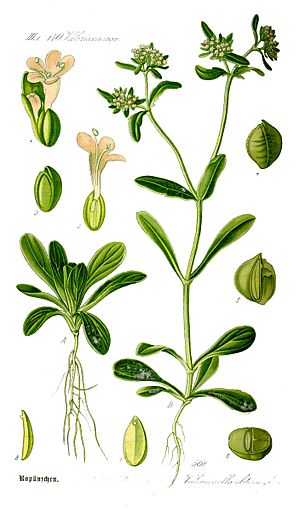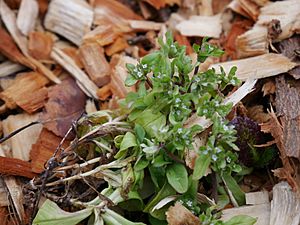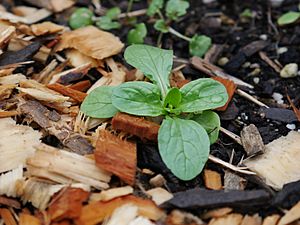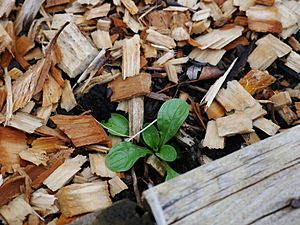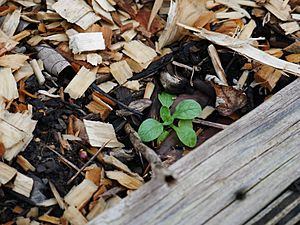Valerianella locusta facts for kids
Quick facts for kids Valerianella locusta |
|
|---|---|
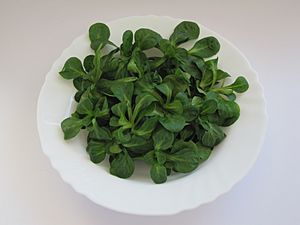 |
|
| Corn salad is identifiable by its rounded leaf and deep green colour | |
| Scientific classification | |
| Genus: |
Valerianella
|
| Species: |
locusta
|
| Synonyms | |
Valerianella locusta, often called mâche (pronounced "mash"), common cornsalad, or lamb's lettuce, is a small, green plant. It's a type of flowering plant that grows every year. This plant belongs to the honeysuckle family, called Caprifoliaceae. It naturally grows in Europe, western Asia, and north Africa. People often eat its leaves as a leaf vegetable.
Contents
What is Cornsalad?
Cornsalad grows close to the ground in a shape like a rosette. Its leaves are shaped like spoons and can be up to 15 centimeters long. This plant is very tough and can grow in cold places. In areas with mild winters, people grow it as a fresh green vegetable during the colder months.
When the weather gets warm, cornsalad tends to "bolt." This means it quickly grows tall stems to produce seeds. These stems have groups of small flowers. The flowers are bluish-white and have five petals joined together. They are very tiny, about 1.5 to 2 millimeters wide. After the flowers are fertilized, they make small seeds.
Where Cornsalad Grows
Cornsalad grows wild in many parts of Europe, northern Africa, and western Asia. In Europe and Asia, you can often find it growing as a weed in farms and empty lots. In North America, it escaped from gardens and now grows wild along the east and west coasts.
As a farmed crop, cornsalad is very popular around Nantes, France. This area is the main place in Europe where mâche is grown.
A Brief History of Cornsalad
For a long time, people in Europe, especially farmers, would gather cornsalad from the wild to eat. A famous gardener named Jean-Baptiste de La Quintinie, who worked for King Louis XIV, started growing it in royal gardens.
Cornsalad has been eaten in Britain for hundreds of years. It was even mentioned in a book about plants from 1597. By the late 1700s, it was sold in markets in London as a winter vegetable. However, it only became common in supermarkets there in the 1980s. In the early 1800s, American president Thomas Jefferson also grew mâche at his home, Monticello, in Virginia.
Different Names for Cornsalad
This plant has many names! Some common ones are lamb's lettuce, common cornsalad, or just cornsalad. It's also called mâche (pronounced "mash"), fetticus, feldsalat, nut lettuce, and field salad.
The name 'cornsalad' comes from the fact that it often grows as a weed in fields where grains like wheat or barley are grown. In this case, 'corn' means 'grain,' not just the yellow corn we eat in the US.
In some parts of Germany, it's called rapunzel. This is where the name of the princess in the famous fairy tale comes from! In fancy restaurants that serve French food, you might see it called doucette or raiponce, instead of mâche.
Why Cornsalad is Good for You
Cornsalad has a special nutty taste, a deep green color, and a soft texture. It's often used in salads.
Just like other wild greens, cornsalad is packed with good things for your body. It has three times more Vitamin C than regular lettuce. It also has beta-carotene, Vitamin B6, iron, and potassium. It's best to pick cornsalad before its flowers appear.
| Nutritional value per 100 g (3.5 oz) | |
|---|---|
|
3.6 g
|
|
|
0.4 g
|
|
|
Protein
|
2 g
|
| Minerals | Quantity
%DV†
|
| Potassium |
15%
459 mg |
| Sodium |
0%
4 mg |
| †Percentages estimated using US recommendations for adults. | |
See also
 In Spanish: Canónigo para niños
In Spanish: Canónigo para niños


